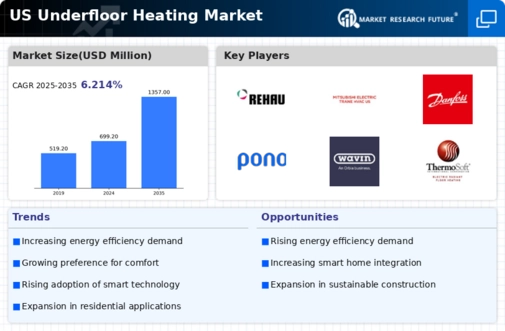Rising Awareness of Health Benefits
The under floor-heating market is driven by the rising awareness of health benefits associated with radiant heating systems. Unlike traditional heating methods, under floor heating provides a more even distribution of heat, reducing the risk of allergens and dust circulation. This is particularly appealing to individuals with respiratory issues or allergies. As health-conscious consumers prioritize indoor air quality, the demand for under floor heating systems is expected to increase. Market Research Future indicates that homes equipped with under floor heating can improve overall comfort and well-being, making this an attractive option for health-oriented buyers in the under floor-heating market.
Regulatory Support for Energy Efficiency
Regulatory support for energy efficiency is a significant driver of the under floor-heating market. Various federal and state policies are encouraging the adoption of energy-efficient heating solutions, including under floor heating systems. Incentives such as tax credits and rebates for energy-efficient home improvements are motivating homeowners to invest in these technologies. The US government has set ambitious energy efficiency goals, aiming for a 50% reduction in energy consumption by 2030. This regulatory environment is likely to foster growth in the under floor-heating market, as consumers seek to comply with regulations while benefiting from lower energy bills and improved comfort.
Increasing Property Values and Market Demand
The under floor-heating market is benefiting from the increasing property values and demand for high-end residential features. Homebuyers are increasingly seeking properties equipped with modern amenities, including under floor heating, which is perceived as a luxury feature. Real estate trends indicate that homes with under floor heating can command a price premium of up to 10% compared to similar properties without this feature. This trend is particularly evident in urban areas where space is limited, and efficient heating solutions are essential. As the demand for energy-efficient and aesthetically pleasing homes continues to rise, the under floor-heating market is likely to see sustained growth, driven by consumer preferences for comfort and luxury.
Technological Advancements in Heating Systems
Technological advancements are playing a crucial role in shaping the under floor-heating market. Innovations such as smart thermostats, advanced insulation materials, and energy-efficient heating cables are enhancing the performance and appeal of under floor heating systems. The integration of IoT technology allows for remote monitoring and control, providing users with greater convenience and energy savings. According to industry reports, the adoption of smart heating solutions is expected to increase by 25% in the next five years, indicating a strong potential for growth in the under floor-heating market. These advancements not only improve efficiency but also enhance user experience, making under floor heating a more attractive option for homeowners.
Growing Focus on Sustainable Heating Solutions
The under floor-heating market is experiencing a notable shift towards sustainable heating solutions. As consumers become increasingly aware of environmental issues, there is a rising demand for energy-efficient systems that reduce carbon footprints. This trend is supported by government initiatives promoting renewable energy sources and energy-efficient technologies. In the US, the Department of Energy has reported that under floor heating can reduce energy consumption by up to 30% compared to traditional heating methods. This growing focus on sustainability is likely to drive innovation and investment in the under floor-heating market, as manufacturers seek to develop eco-friendly products that align with consumer preferences.




















Leave a Comment